Evaluation of Subsidy Programmes
The work in the group “Evaluation of Subsidy Programmes” combines high quality research with policy advice. Its overarching objective is to improve the foundation of causal impact analysis of policy intervention in the European Union. The research in this group directly addresses shortcomings regarding the current practice of policy evaluations, particularly in the fields of subsidy programmes and financial markets interventions. Currently, systematic evaluation in these research areas is underdeveloped in the European Union relative to that in other highly developed economies such as the U.S.[1] or U.K.[2]
By developing blueprints, this research group aims at demonstrating how evidence-based policy evaluation that is in line with international evaluation standards can contribute to better informed policy-making. We highlight that this challenge can only be met by an integrated approach combining three dimensions: state-of-the-art econometric methods of causal impact analysis; the management of big data; and multilateral knowledge transfer between the scientific community, policy-makers/administrative staff and society. By bringing together these dimensions, this project will develop sustainable evaluation practices for researchers and policy-makers and act as a data source for the scientific community.
An example for policy advice in the first competence field (evaluation of subsidy programmes) is the causal impact analysis of the "Joint Task of 'Improving the Regional Economic Structure'" (which is the most important regional policy support scheme in Germany). The objective of the project is to use different evaluation techniques to assess the impact of policy measures. Thereby policy gains a better understanding of regional structural changes and regional economic growth.
In the second key area (evaluation of financial market interventions) the project analyses regulatory reforms and effects. Having in mind that after the recent financial crisis, a re-regulation of the financial system took place, it is of utmost importance to evaluate the effectiveness of the reforms as well as to assess whether there are unintended side-effects.
In the context of the project “The Political Economy of the European Banking Union” researchers in the financial markets department study how the directives underlying the European Banking Union are implemented across member states as well as whether the new regulatory framework has implications for banking stability and financial intermediation.
IWH Data Project: IWH Subsidy Database
The data project deals with the completion and preparation of comprehensive and unique data sets including information about granted R&D projects and institutional frameworks. The database includes support schemes on federal, federal state, and EU level.[3]
[1] Examples are Mathematica Policy Research (a pioneering nonpartisan research organisation, for details see https://www.mathematica-mpr.com/about-mathematica) or the Commission on Evidence-Based Policymaking established by the bipartisan Evidence-Based Policymaking Commission Act of 2016 (Public Law 114–140, for details see https://www.cep.gov/about.html).
[2] Examples are The Behavioural Insights Team (BIT) (for details see http://www.behaviouralinsights.co.uk/about-us/), the Innovation Growth Lab (IGL) (for details see http://www.innovationgrowthlab.org/innovation-growth-lab), and the What Works Centre for Local Economic Growth (for details see http://www.whatworksgrowth.org/about-us/).
[3] For a description of the database, see https://www.iwh-halle.de/en/research/data-and-analysis/research-data-centre/iwh-subsidy-database/ and Brachert, M.; Giebler, A.; Heimpold, G.; Titze, M.; Urban-Thielicke, D.: IWH-Subventionsdatenbank: Mikrodaten zu Programmen direkter Unternehmenssubventionen in Deutschland. Datendokumentation. IWH Technical Report 2/2018. Halle (Saale) 2018.
Research Cluster
Economic Dynamics and StabilityYour contact

- Department Centre for Evidence-based Policy Advice, Cep
EXTERNAL FUNDING
09.2019 ‐ 09.2022
Establishing Evidence-based Evaluation Methods for Subsidy Programmes in Germany (EVA-KULT)
The project aims at expanding the Centre for Evidence-based Policy Advice at the Halle Institute for Economic Research (IWH-CEP).
01.2018 ‐ 12.2020
Networked growth - Innovative Saxony-Anhalt through digital business models (Competence Center 4.0)
01.2017 ‐ 12.2018
Political Participation in Eastern Germany
12.2015 ‐ 11.2018
Socio-economic Effects of Research on Innovative Approaches for POC Diagnostics
Part of the EXASENS project. Coordinated by the Leibniz Institute of Photonic Technology (IPHT) in Jena, nine Leibniz institutes are working together on researching point-of-care (POC) technology for the prediction and diagnosis of chronic inflammatory respiratory diseases. See press release.
02.2017 ‐ 02.2018
The Importance of Non-University Research Institutions for the Development of Firms and Regions (Be_For_Reg-Projekt)
01.2015 ‐ 12.2016
Evaluation of the "Joint Task 'Improving the Regional Economic Structure'" in the Federal State of Saxony-Anhalt
Refereed Publications
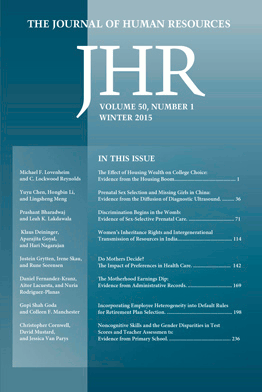
A Professor Like Me: The Influence of Instructor Gender on College Achievement
in: Journal of Human Resources, No. 2, 2009
Abstract
Many wonder whether teacher gender plays an important role in higher education by influencing student achievement and subject interest. The data used in this paper help identify average effects from male and female college students assigned to male or female teachers. We find instructor gender plays only a minor role in determining college student achievement. Nevertheless, the small effects provide evidence that gender role models matter to some college students. A same-sex instructor increases average grade performance by at most 5 percent of its standard deviation and decreases the likelihood of dropping a class by 1.2 percentage points.

Soll die Höhe von Investitionszuschüssen an die Einführung von Umweltmanagementsystemen gekoppelt werden?
in: List Forum für Wirtschafts- und Finanzpolitik, No. 1, 2009
Abstract
In jeder arbeitsteiligen Gesellschaft ist Wirtschaftspolitik erforderlich. Im Rahmen der Wirtschaftspolitik wird versucht, ein komplexes Geflecht von Zielen zu erreichen. Es kann auch vorkommen, dass mit dem Erreichen eines Ziels ein anderes geschwächt wird. Dies ist Gegenstand des vorliegenden Beitrags. Konkret geht es um das Ziel Verbesserung der Wirtschaftsstruktur und das Umweltziel. Das Strukturziel wird in der Bundesrepublik Deutschland unter anderem über die Investitionszuschüsse im Rahmen der Gemeinschaftsaufgabe ‚Verbesserung der regionalen Wirtschaftsstruktur‘ verfolgt, die über die Länder ausgereicht werden. Einige Länder sind dazu übergegangen, die Gewährung von Investitionszuschüssen an Sekundärziele, zum Beispiel auch den Umweltschutz, zu knüpfen. Der vorliegende Beitrag beschreibt einen aktuellen Fall aus dem politischen Diskussionsprozess, in dem die Höhe des Fördersatzes an die Einführung von so genannten Umweltmanagementsystemen gebunden wird. Der Beitrag zeigt, dass unter bestimmten Konstellationen die Investitionstätigkeit gebremst wird und gleichzeitig Umweltmanagementsysteme nicht eingeführt werden. Damit hätte man beide Ziele nicht erreicht. Der bessere Weg bestünde in der direkten Unterstützung von Unternehmen, bei denen ein Umweltmanagementsystem sinnvoll ist, wie es bereits durch Programme auf Landesebene praktiziert wird.
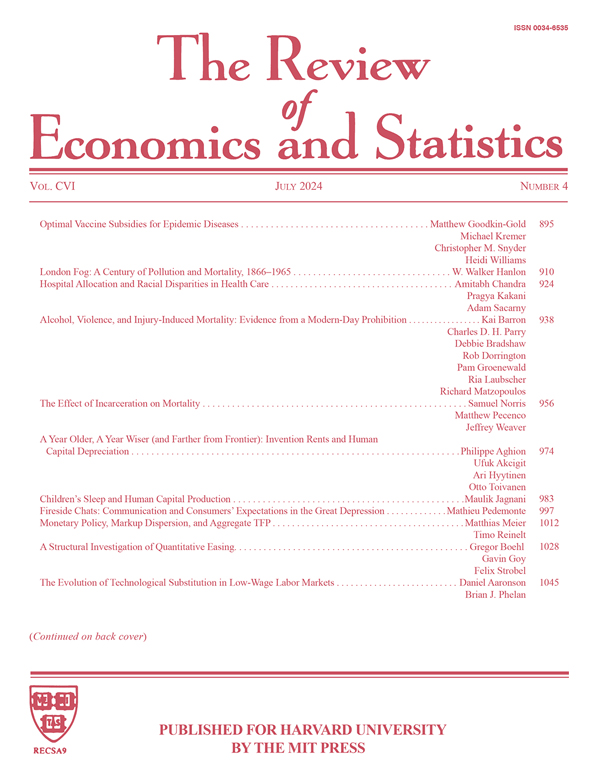
Professor Qualities and Student Achievement
in: Review of Economics and Statistics, No. 1, 2009
Abstract
This paper analyzes the importance of teacher quality at the college level. Instructors are matched to objective and subjective characteristics of teacher quality to estimate the impact of rank, salary, and perceived effectiveness on student performance and subject interest. Student and course fixed effects, time of day and week controls, and students' lack of knowledge about first-year instructors help minimize selection biases. Subjective teacher evaluations perform well in measuring instructor influences on students, while objective characteristics such as rank and salary do not. Overall, the importance of college instructor differences is small, but important outliers exist.
Working Papers
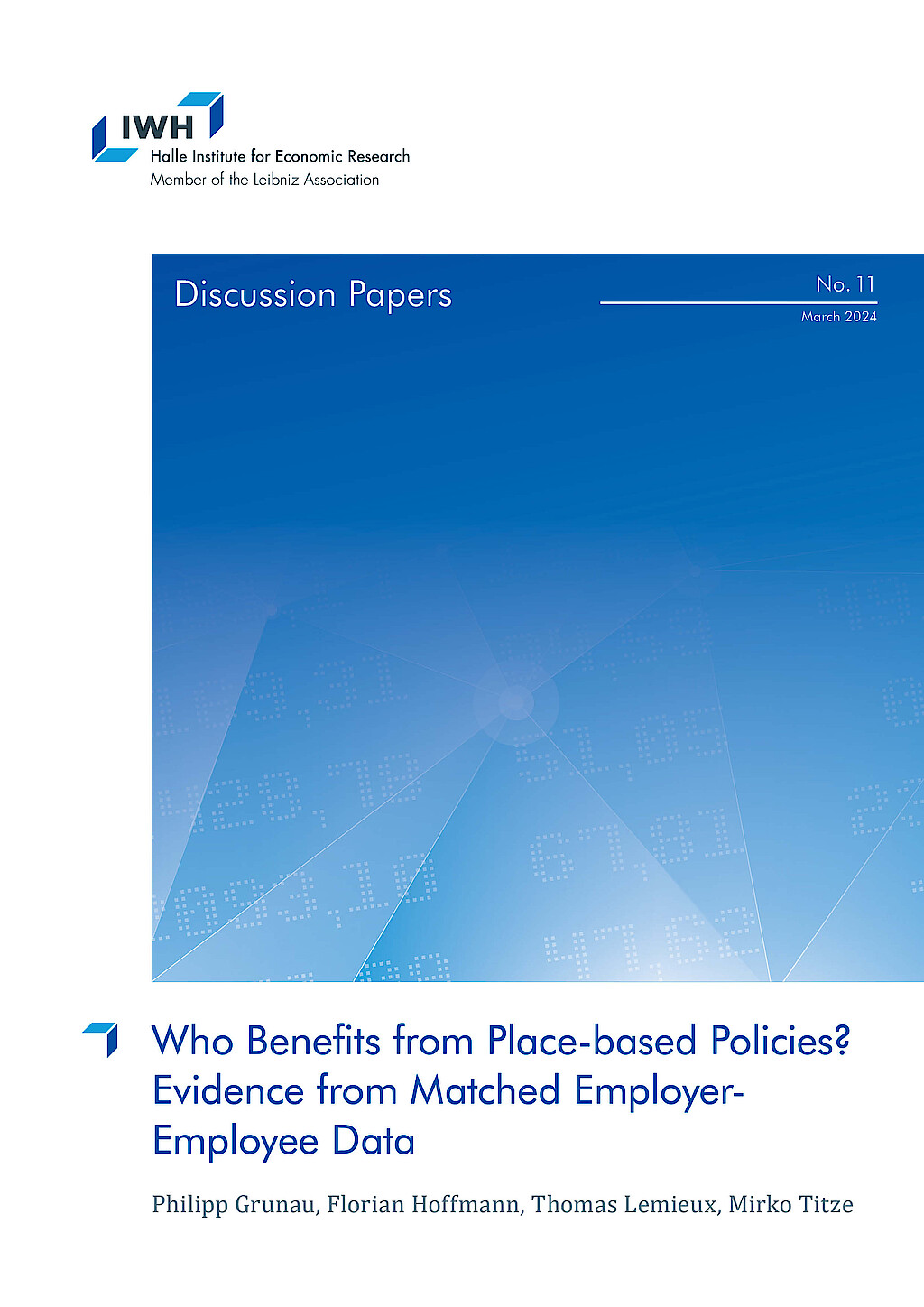
Who Benefits from Place-based Policies? Evidence from Matched Employer-Employee Data
in: IWH Discussion Papers, No. 11, 2024
Abstract
We study the wage and employment effects of a German place-based policy using a research design that exploits conditionally exogenous EU-wide rules governing the program parameters at the regional level. The place-based program subsidizes investments to create jobs with a subsidy rate that varies across labor market regions. The analysis uses matched data on the universe of establishments and their employees, establishment-level panel data on program participation, and regional scores that generate spatial discontinuities in program eligibility and generosity. These rich data enable us to study the incidence of the place-based program on different groups of individuals. We find that the program helps establishments create jobs that disproportionately benefit younger and less-educated workers. Funded establishments increase their wages but, unlike employment, wage gains do not persist in the long run. Employment effects estimated at the local area level are slightly larger than establishment-level estimates, suggesting limited spillover effects. Using subsidy rates as an instrumental variable for actual subsidies indicates that it costs approximately EUR 25,000 to create a new job in the economically disadvantaged areas targeted by the program.

Employment Effects of Investment Grants and Firm Heterogeneity – Evidence from a Staggered Adoption Approach
in: IWH Discussion Papers, No. 6, 2023
Abstract
<p>This study estimates the firm-level employment effects of investment grants in Germany. In addition to the average treatment effect on the treated, we examine discrimination in the funding rules as potential source of effect heterogeneity. We combine a staggered difference-in-differences approach that explicitly models variations in treatment timing with a matching procedure at the cohort level. The findings reveal a positive effect of investment grants on employment development in the full sample. The subsample analysis yields strong evidence for heterogeneous effects based on firm characteristics and the economic environment. This can help to improve the future design of the program.</p>

flexpaneldid: A Stata Toolbox for Causal Analysis with Varying Treatment Time and Duration
in: IWH Discussion Papers, No. 3, 2020
Abstract
The paper presents a modification of the matching and difference-in-differences approach of Heckman et al. (1998) for the staggered treatment adoption design and a Stata tool that implements the approach. This flexible conditional difference-in-differences approach is particularly useful for causal analysis of treatments with varying start dates and varying treatment durations. Introducing more flexibility enables the user to consider individual treatment periods for the treated observations and thus circumventing problems arising in canonical difference-in-differences approaches. The open-source flexpaneldid toolbox for Stata implements the developed approach and allows comprehensive robustness checks and quality tests. The core of the paper gives comprehensive examples to explain the use of the commands and its options on the basis of a publicly accessible data set.
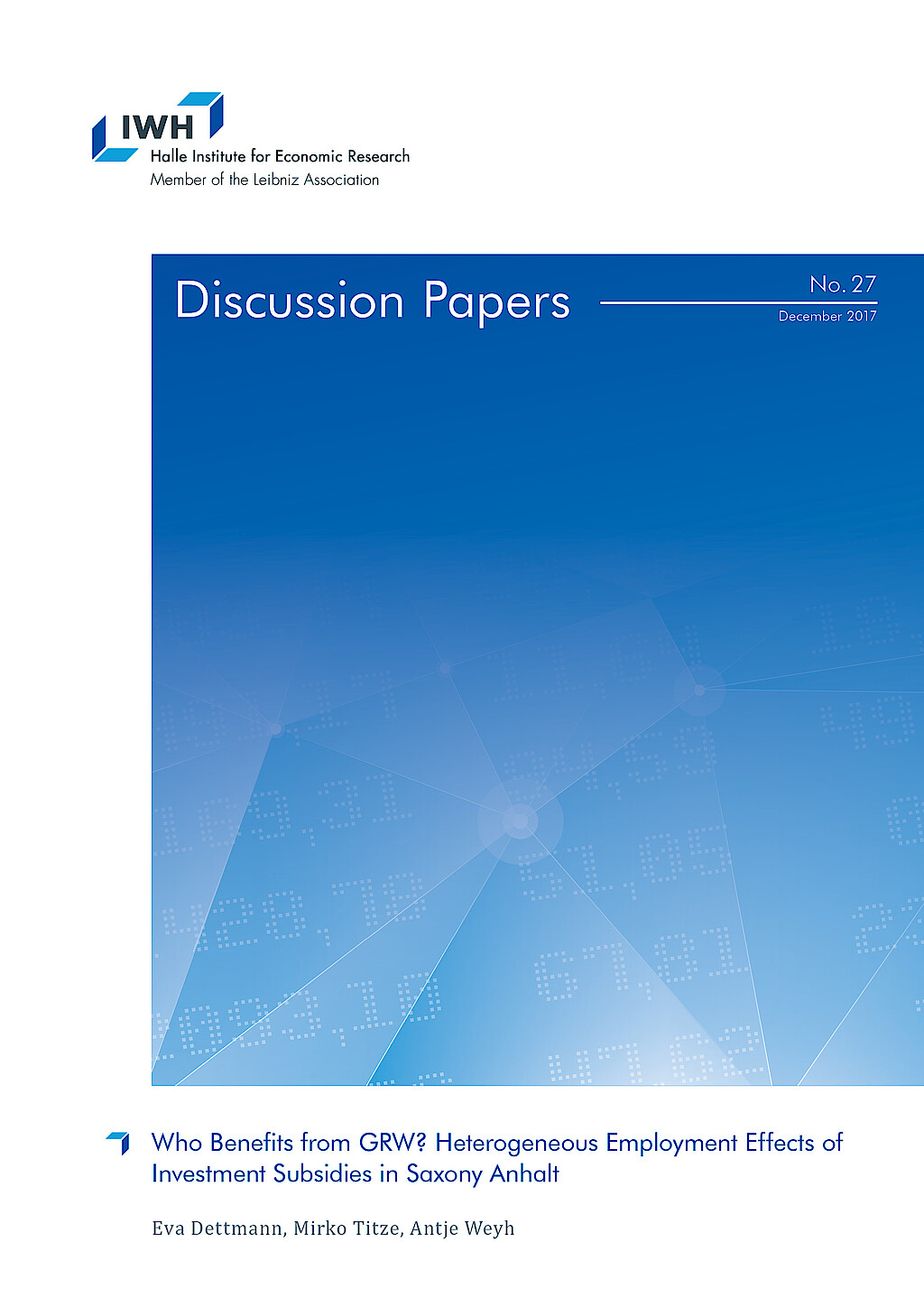
Who Benefits from GRW? Heterogeneous Employment Effects of Investment Subsidies in Saxony Anhalt
in: IWH Discussion Papers, No. 27, 2017
Abstract
The paper estimates the plant level employment effects of investment subsidies in one of the most strongly subsidized German Federal States. We analyze the treated plants as a whole, as well as the influence of heterogeneity in plant characteristics and the economic environment. Modifying the standard matching and difference-in-difference approach, we develop a new procedure that is particularly useful for the evaluation of funding programs with individual treatment phases within the funding period. Our data base combines treatment, employment and regional information from different sources. So, we can relate the absolute effects to the amount of the subsidy paid. The results suggest that investment subsidies have a positive influence on the employment development in absolute and standardized figures – with considerable effect heterogeneity.
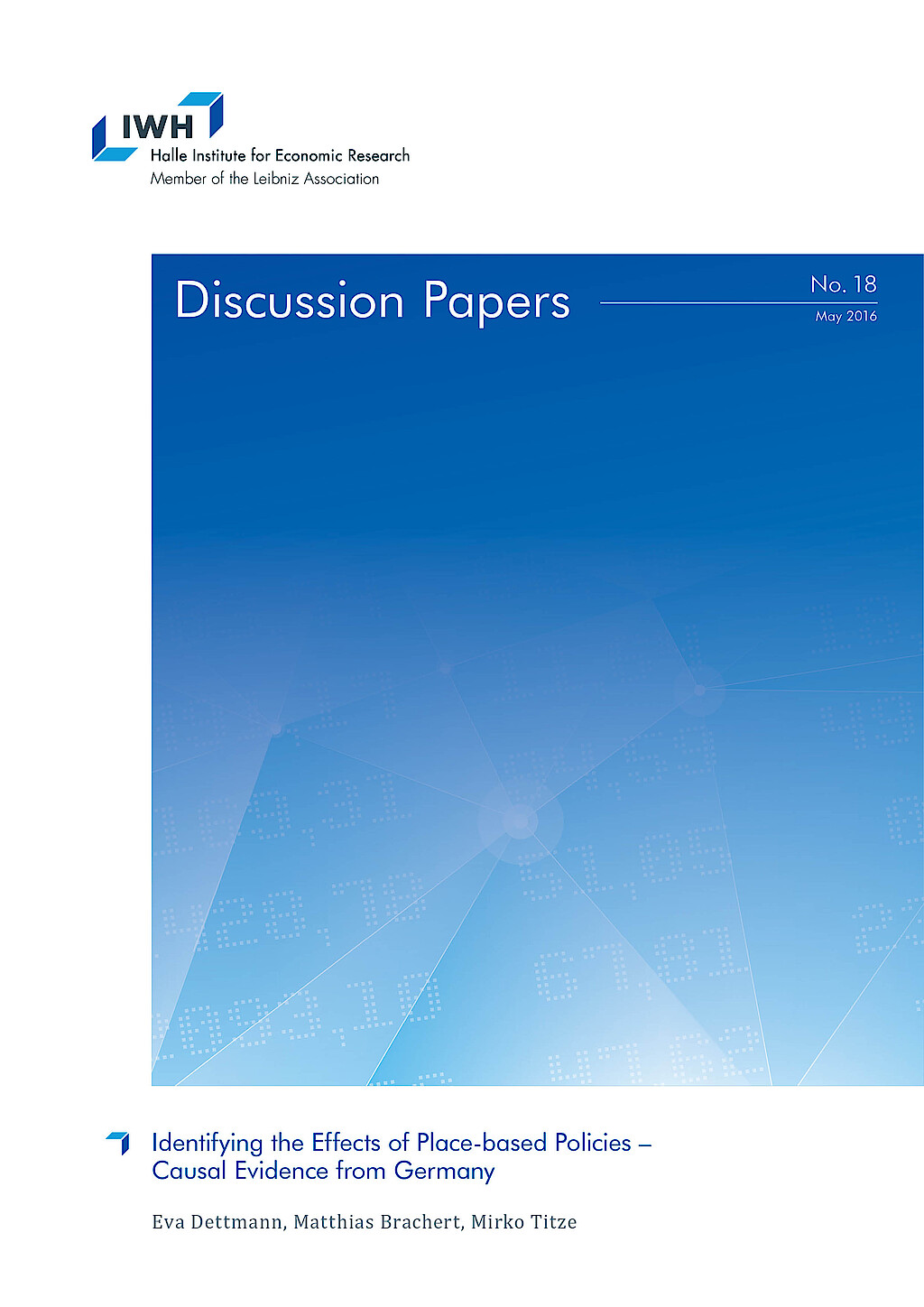
Identifying the Effects of Place-based Policies – Causal Evidence from Germany
in: IWH Discussion Papers, No. 18, 2016
Abstract
The German government provides discretionary investment grants to structurally weak regions to reduce regional disparities. We use a regression discontinuity design that exploits an exogenous discrete jump in the probability of receiving investment grants to identify the causal effects of the investment grant on regional outcomes. We find positive effects for regional gross value-added and productivity growth, but no effects for employment and gross wage growth.














